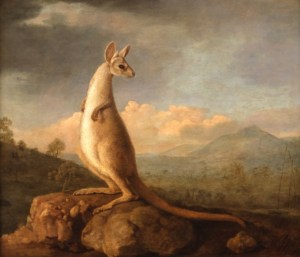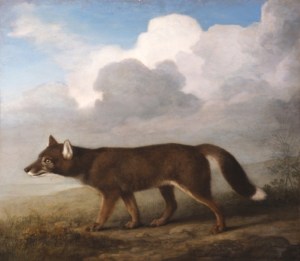Last week Royal Museums Greenwich successfully pulled off the most ambitious acquisition appeal in their history. With help from the Heritage Lottery Fund, The Monument Trust, the Art Fund, the Eyal Ofer Family and many others, the museum has acquired two paintings by George Stubbs: The Kongouro from New Holland and Portrait of a Large Dog (Dingo). Painted by Stubbs in 1772, and first exhibited at the Royal Academy in 1773, these were the first images of Australian animals to be shown in Britain.

The Kongouro from New Holland (Kangaroo) (1772), George Stubbs Courtesy of Nevill Keating Pictures
The paintings were commissioned from Stubbs by Sir Joseph Banks, a wealthy naturalist and collector who accompanied Captain James Cook in H.M.S. Endeavour on his first voyage to the South Pacific (1769–1771). As well as observing the transit of Venus from Tahiti, they ‘discovered’ and surveyed large parts of New Zealand and Australia, collecting specimens of flora and fauna. Artists employed by Banks also sketched and painted what they encountered.
The story goes that in 1770 the kangaroo was killed by Banks’ dog, while the Endeavour was being repaired in what is now known as Endeavour River after coming to grief on the Great Barrier Reef. Banks brought the skin to London, along with sketches by expedition artist Sydney Parkinson, skulls from animals eaten by the crew and a description of a type of canine, and commissioned the painting along with the Dingo from Stubbs, the foremost animal painter of his day.
For Royal Museums Greenwich, the paintings present the opportunity to bring the paintings back together, for the first time, with Nathaniel Dance’s portrait of Cook, (already in the collections) with which they hung in Banks’ Soho Square house in the 1770s and 1780s. The paintings join an unrivalled collection of objects relating to all of Cook’s three Pacific voyages. As well as manuscripts, drawings, navigational instruments and objects from encounters in the Pacific, the museum has paintings by William Hodges from Cook’s second voyage (1772–1775) and by John Webber from his third (1776–1780).

Portrait of a Large Dog (Dingo) (1772), George Stubbs Courtesy of Nevill Keating Pictures
Putting the Stubbs on display in the museum’s Palladian jewel – the Queen’s House, designed by Inigo Jones – alongside these rich collections will create a new centre for the RMG. It is first in a series of projects to enhance the Queen’s House in time for its 400th anniversary in 2016.
This is an exciting time for me, having just joined the museum as the Curator of Art pre-1800, as the paintings come under my care! While I can claim no responsibility for the successful acquisition campaign, I do get the chance to be involved in thinking about how we now display and interpret them.
Their first outing after a thorough check-over in the conservation department will be in a display on ‘The Art and Science of Exploration’ on which I’m working with my colleagues Barbara Tomlinson and Christine Riding. How do you go about getting across the sense of the complete unknown that those RA visitors must have felt on seeing Stubbs’ paintings in 1773? That’s what we’ll be thinking about over the next few months.

Rehomed
The Kongouro from New Holland (Kangaroo) (1772), George Stubbs Courtesy of Nevill Keating Pictures
Share
Last week Royal Museums Greenwich successfully pulled off the most ambitious acquisition appeal in their history. With help from the Heritage Lottery Fund, The Monument Trust, the Art Fund, the Eyal Ofer Family and many others, the museum has acquired two paintings by George Stubbs: The Kongouro from New Holland and Portrait of a Large Dog (Dingo). Painted by Stubbs in 1772, and first exhibited at the Royal Academy in 1773, these were the first images of Australian animals to be shown in Britain.
The Kongouro from New Holland (Kangaroo) (1772), George Stubbs Courtesy of Nevill Keating Pictures
The paintings were commissioned from Stubbs by Sir Joseph Banks, a wealthy naturalist and collector who accompanied Captain James Cook in H.M.S. Endeavour on his first voyage to the South Pacific (1769–1771). As well as observing the transit of Venus from Tahiti, they ‘discovered’ and surveyed large parts of New Zealand and Australia, collecting specimens of flora and fauna. Artists employed by Banks also sketched and painted what they encountered.
The story goes that in 1770 the kangaroo was killed by Banks’ dog, while the Endeavour was being repaired in what is now known as Endeavour River after coming to grief on the Great Barrier Reef. Banks brought the skin to London, along with sketches by expedition artist Sydney Parkinson, skulls from animals eaten by the crew and a description of a type of canine, and commissioned the painting along with the Dingo from Stubbs, the foremost animal painter of his day.
For Royal Museums Greenwich, the paintings present the opportunity to bring the paintings back together, for the first time, with Nathaniel Dance’s portrait of Cook, (already in the collections) with which they hung in Banks’ Soho Square house in the 1770s and 1780s. The paintings join an unrivalled collection of objects relating to all of Cook’s three Pacific voyages. As well as manuscripts, drawings, navigational instruments and objects from encounters in the Pacific, the museum has paintings by William Hodges from Cook’s second voyage (1772–1775) and by John Webber from his third (1776–1780).
Portrait of a Large Dog (Dingo) (1772), George Stubbs Courtesy of Nevill Keating Pictures
Putting the Stubbs on display in the museum’s Palladian jewel – the Queen’s House, designed by Inigo Jones – alongside these rich collections will create a new centre for the RMG. It is first in a series of projects to enhance the Queen’s House in time for its 400th anniversary in 2016.
This is an exciting time for me, having just joined the museum as the Curator of Art pre-1800, as the paintings come under my care! While I can claim no responsibility for the successful acquisition campaign, I do get the chance to be involved in thinking about how we now display and interpret them.
Their first outing after a thorough check-over in the conservation department will be in a display on ‘The Art and Science of Exploration’ on which I’m working with my colleagues Barbara Tomlinson and Christine Riding. How do you go about getting across the sense of the complete unknown that those RA visitors must have felt on seeing Stubbs’ paintings in 1773? That’s what we’ll be thinking about over the next few months.
Unlimited access from just $16 every 3 months
Subscribe to get unlimited and exclusive access to the top art stories, interviews and exhibition reviews.
Share
Recommended for you
Ideal Man
The Musée d’Orsay’s exhibition of male nudes is almost a great show, but it misses a timely opportunity to explore homoerotic sentiment in art
First Look: Turner and the Sea
Christine Riding, Senior Curator of Arts at the Royal Museums Greenwich, introduces ‘Turner and the Sea’
Book Competition
This month’s book competition offers you the chance to win ‘Sex on Show: Seeing the Erotic in Greece and Rome’ by Caroline Vout